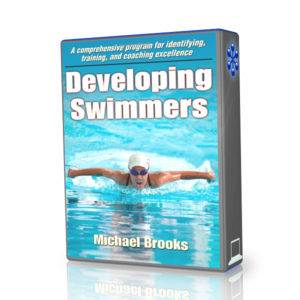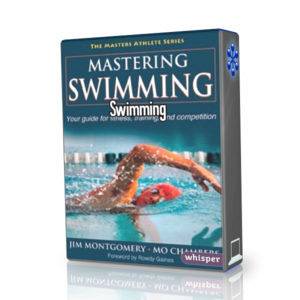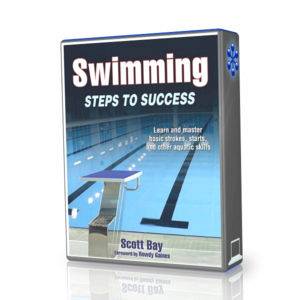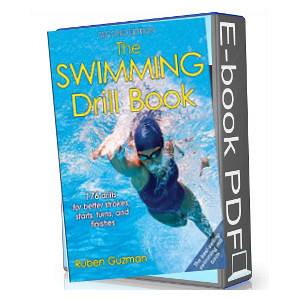Breathing in the butterfly happens within the line of the stroke, so that the swimmer inhales when the upper body is naturally at its highest point, and finishes when the upper body regains its downhill position. Timed correctly, no independent head action is required to achieve a breath. The most economic breathing style is low on the water, facing forward. Regular, rhythmic breathing is important to achieving a sustainable stroke, but successful butterfliers use a variety of breathing patterns, from breathing every stroke, to breathing every third stroke. The goal of the following breathing drills for butterfly is to practice the correct timing of the breathing so it happens with the natural rhythm of the stroke.
Breathing Timing Drill
THE PURPOSE OF THIS DRILL
- Learning the timing of the butterfly breathing
- Achieving the inhale at the high point of the stroke
- Feeling the face return to the water before the hands
HOW TO DO THIS DRILL
- Step 1 : - Stand in waist deep water. Keeping your feet firmly on the bottom of the pool, bow forward so your face is in the water. Look at the bottom of the pool. Extend your arms forward on the surface of the water, aligning your elbows and thumbs forward. Begin tracing the question mark line of your arm stroke. As your hands press back and accelerate to the end of the stroke, stand upright.
- Step 2 : - Inhale as you achieve your full standing position, while your hands press quickly back and round off the finish of the stroke. As your hands leave the water, pinkies-up and move into the arch of the recovery, again bow forward so your body joins the forward line of the arms as they go over the water. Your face should submerge just before your hands enter the water in front.
- Step 3 : - Begin another stroke, and stand as your hands transition to the fast finish. Inhale. Bow forward again as your arms recover, allowing your face to reach the water before your hands. Do several strokes, standing to inhale at the end of each one. As you move into the recovery and bow forward, notice that your head and arms move in unison towards the front. Your head should beat your arms to the water because it has a shorter distance to travel.
- Step 4 : - Now try several strokes in a row. Bow forward to begin each stroke with your face in the water. Stand and inhale as your hands approach the back of the stroke. Bow forward again as your arms recover, so your face reaches the water an instant before your hands.
- Step 5 : - Continue to practice, focusing on inhaling at the high point of your stroke. Allow your body position to determine when your breath begins and ends.

DRILL FEEDBACK CHART
| Problem | Modification |
| My hands and face hit the water at the same time. | Try to get your face back to the water before your hands. Although they should be travelling in unison, your arms have a longer path to travel, so your face should reach the water first. |
| It seems like I am pressing down on the water, not back. | In this drill, since you are vertical, you will initially be pressing down. Try to pay attention to the timing of the breathing rather than the path of the stroke in this drill. |
| When my face hits the water, my hands are already stroking. | You might be breathing too late. Time the inhale to end as the arms are reaching forward toward the Y. |
Flying Dolphin Dives
THE PURPOSE OF THIS DRILL
- Learning the timing of the butterfly breathing
- Breathing within the line of the stroke
- Feeling the wave of the stroke
HOW TO DO THIS DRILL
- Step 1 : - Stand in water that is hip deep, arms extended back and outside the hips, pinkies-up. Achieve a straight spine from your hips through your neck. Keeping your hips firm, bow forward about twelve inches while bending your knees slightly, preparing to jump off the bottom of the pool.
- Step 2 : - Jump off the bottom with force. As your body rises into the air, bow forward more, and swing your arms around and forward like a butterfly recovery. Your arms should be finishing their recovery as your body begins to descend. As your face enters the water, your hips should actually be higher than your head, and your arms should be extended, and in the water, aiming downward toward the bottom of the pool.
- Step 3 : - As your arms descend, your upper body, legs and feet should be following the same line, travelling up, over, then down into the water. Before you reach the bottom of the pool, sweep through the butterfly arm stroke, and raise your upper body out of your bow. Feel your legs and feet react to the change of direction. As your face rises to the surface of water, feel your feet snap down into the water, as your hands reach the end of the stroke. Draw your legs up under you as you resume the standing position. Inhale.
- Step 4 : - From the starting position, standing with your arms extended back and out from your body, begin another dolphin dive. Jump up and swing your arms into the re- covery as you bow forward. Continue to bow forward so that by the high point of your jump, your hips are higher than your head, and your arms are pointing down toward the water. As you descend into the water, trace the butterfly arm stroke as you come out of your bow. Finish your stroke as your face rises out of the water and your feet snap down. Inhale and resume your starting position.
- Step 5 : - Perform several flying dolphin dives in a row, using the high point of each to inhale. Travel up, over, then down into the water with each one, maintaining a fluid rhythm from one to the next.

DRILL FEEDBACK CHART
| Problem | Modification |
| I am landing flat on the water. | Bow forward more to start. Then bow forward even more as you jump up and swing of your arms of y around forward. Your legs shoud stil be risisng when your arms have finished their recovery, and are pointing with your head down toward the water. |
| My face doesn't clear the water until I stand. | As your arms finish the stroke and you come out of your bow, allow your legs to follow the same wave until wour feet snap down. That will naturally lift your face to the surface before you stand up completely. |
| My face comes out of the water before my feet snap down. | This could means that you are raising your chin to breathe, rather than breathing within the wave of the dolphin dive. Hold your head position firm throughout the whole drill. Achieve your breathe at the high point of the dolphin dive, without changing your head position. |
Eyes on the Water Butterfly
THE PURPOSE OF THIS DRILL
- Learning to maintain a stable head position
- Practicing looking down at the water while breathing
- Using the natural wave to the stroke to breathe
HOW TO DO THIS DRILL
- Step 1 : - Push off the wall preparing to do the butterfly, straight spine, arms extended in front of you, looking down at the bottom of the pool. Do several dolphins to establish your rhythm, then start your arm stroke. Sweep around and accelerate to the rear. Finish fast and feel your upper body rise. Breathe and begin the recovery. When your hands pass your shoulders and your chest drops down, allow your head to return to the water as you realign your arms to reach forward in a Y.
- Step 2 : - Continue into a second stroke. Look at the bottom of the pool. Maintain a firm spine, from your hips through to your neck. As your arms begin to sweep through the stroke, feel your upper body start to rise. As your arms accelerate to the finish, your feet should snap down again, propelling your face to the surface of the water. Inhale without changing your head position.
- Step 3 : - Continue into the recovery. Your head should be moving in unison with your arms, continuing the forward line of the stroke. When your arms pass your shoulders, your face should enter the water as your chest drops down and flops your arms forward. Your arms enter the water a moment after your head, as you achieve the downhill position.
- Step 4 : - Continue into a third stroke. Stroke through to the rear, accelerating as you press against the water. As you finish the stroke quickly, allow your feet to snap down. Feel your upper body rise, and your face pop to the surface. Inhale looking down at the water directly in front of you. If you have maintained a stable head position, you should not be able to see the far end of the pool. Recover and feel your face submerge as your feet snap down again and you move into the downhill position.
- Step 5 : - Perform a fourth stroke, accelerating through and allowing your feet to snap down as your finish your stroke. Feel your upper body rise. Inhale at your highest point, maintaining your head position. At the highest point, your chin should be just above the surface of the water, and you should be looking down at the water right in front of you. As you proceed into the recovery, drop your chest and face into the water. Notice that without changing your head position, you are again looking at the bottom of the pool.
- Step 6 : - Practice more, achieving each breath within the line of your stroke. Maintain a stable head position throughout the stroke, so you are looking down at the bottom of the pool when your face is in the water, and down at the water in front of you when you are inhaling.

DRILL FEEDBACK CHART
| Problem | Modification |
| My face doesn't pop out of the water. | Make sure you are finishing the stroke quickly, and that your feet are snapping down at the same time, giving you the lift you need to breathe. Also, make sure that your dolphin begins high in your body, and that you are not snapping your feet down as an independent action by over-bending at the knee. |
| I see the other end of the pool when I am inhaling. | This means you are raising your chin to breathe. Doing so compromises the straight spine line of the stroke. Instead, keep your chin down, so you will maintain a stronger position to start the next stroke. |
| My chin is much higher than the surface of the water when I am inhaling. | You might be pressing down on the water to achieve lift. Although you will be able to get your breath this way, it is very difficult to sustain high breathing, as you are spending a great deal of energy going up rather than forward. |
Hammer and Nail
THE PURPOSE OF THIS DRILL
- Learning to breathe from the core
- Shifting to a downhill position after breathing
- Maintaining a stable head position
HOW TO DO THIS DRILL
- Step 1 : - Push off the wall for the butterfly. Dolphin several times to establish rhythm, then start your arm stroke. Sweep through and accelerate to the rear. Finish fast as your feet snap down and feel your upper body rise. Inhale at the high point, looking down at the water. Recover, rolling your shoulders forward and dropping your chest down as your arms reach for the front. Feel your face return to the water and achieve the downhill position. Focus on what part of your face hits the water first.
- Step 2 : - Do another stroke. After the inhale, as your arms and head move back to the starting position, freeze as your face hits the water. It should hit the water forehead first, rather than chin first. It should feel like your forehead hits like a hammer and the water is a nail.
- Step 4 : - Do another stroke. As you accelerate to the rear and your upper body rises for the breath, focus on the arch of arms as they pass over the water. From the beginning to the end of the recovery, the forward movement of the arms is powered from the core, not the arms. The core action actually determines the line of the stroke. As you roll your shoulders forward, feel your head leave the high point of the stroke. As your hands pass your shoulders, and you drop your chest down into the water, the line of the stroke aims down and forward, bringing your face back to the water forehead first, and positioning your body downhill to begin the next stroke.
- Step 5 : - Notice that without changing your head position at all, you rise from the water to breathe forehead first, and you also return to the water forehead first. Practice more, using your forehead as the hammer to hit the nail that is the water. Do so with force, carrying the momentum of your recovery into the next stroke.

DRILL FEEDBACK CHART
| Problem | Modification |
| I hit the nail with my chin. | Make sure that you are maintaining a straight spine through to your neck throughout the entire breathing action. This means you are looking at the water during the inhale, not forward. Then, make sure that you are using your core to swing your arms around and forward during recovery, not just your arms. Roll your shoulders forward then drop your chest to change how your face enters the water. |
| When I hit the nail with my forehead my arms aim down. | Reach forward with your arms while your chest drops down. Doing so will allow you to keep moving forward while transitioning to the downhill position. |
| I don't feel momentum from the recovery. | Make sure your hands are relaxed, so they are not initiating the recovery. The motion should come from your core, in the middle of the arch of your two arms. Use your core to aim your body up and forward to breathe, and down and forward to return your face to the water, and to prepare for the next stroke. |






